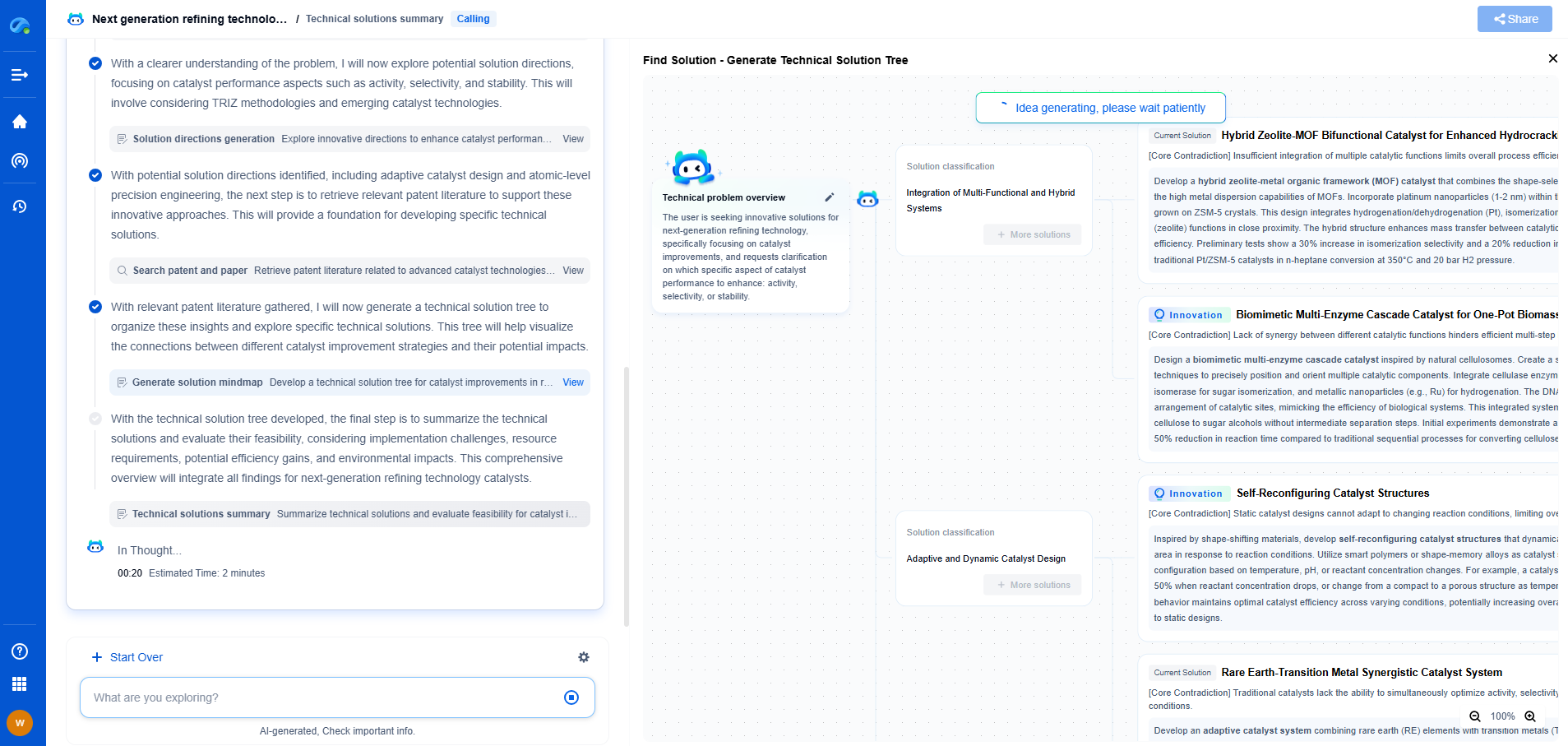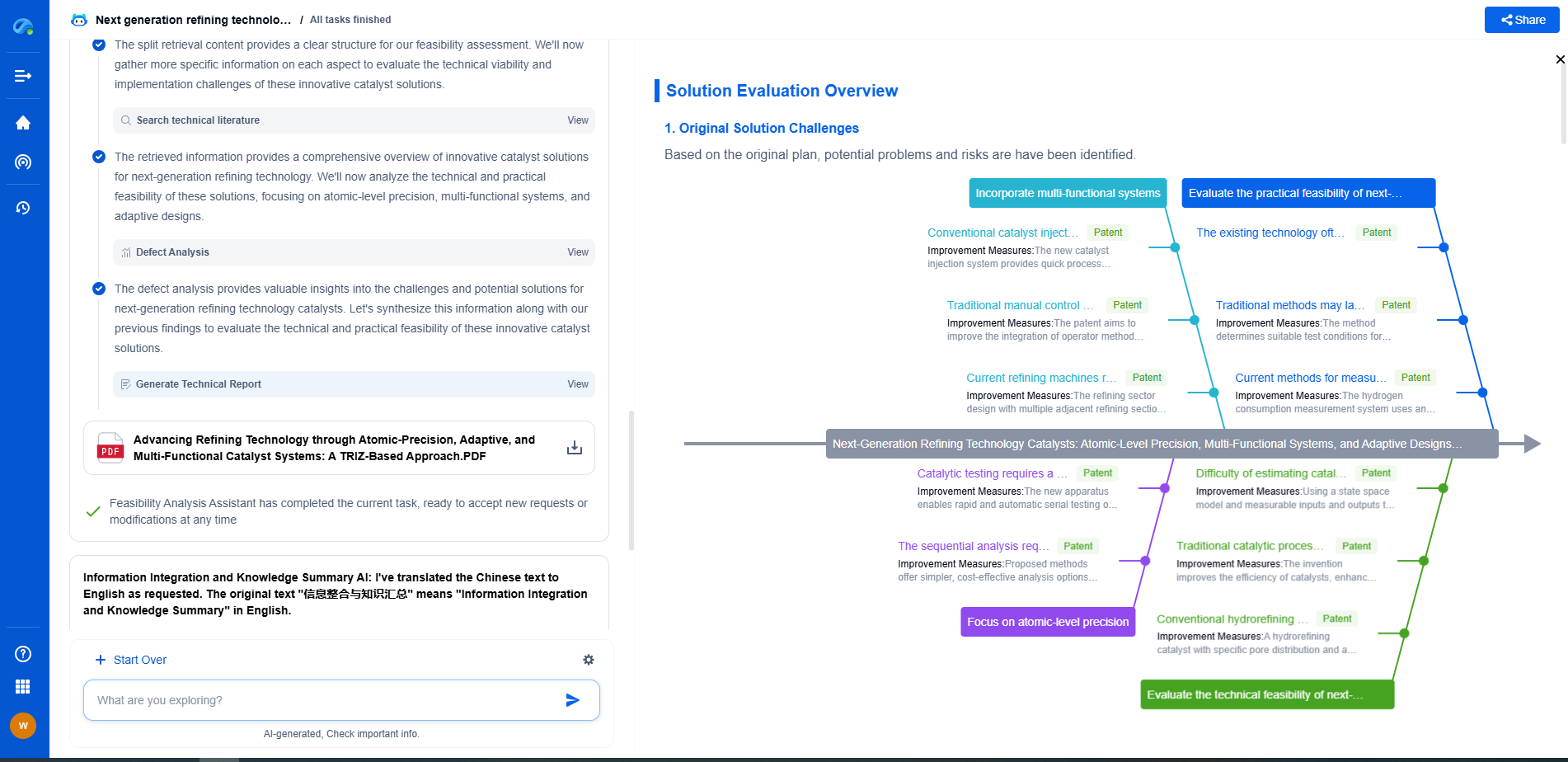How to Identify Gear Wear Patterns and Their Root Causes
JUL 2, 2025 |
Gears are fundamental components in various mechanical systems, translating power and motion between different parts of a machine. Over time, gears may show signs of wear, which could lead to reduced performance, increased noise, or even complete failure. Identifying these wear patterns is crucial for maintenance and prevention of future issues. In this article, we will explore common gear wear patterns, their root causes, and strategies for addressing these challenges.
Types of Gear Wear Patterns
1. **Uniform Wear**
Uniform wear is a normal condition where the gear teeth evenly wear down over time. This type of wear is generally considered acceptable as it indicates that the gears are properly aligned and lubricated. However, excessive uniform wear can still indicate that the gear system is reaching the end of its lifespan and may need replacement soon.
2. **Pitting**
Pitting occurs when small, crater-like pits form on the surface of the gear teeth. This type of wear is often caused by excessive loads, improper lubrication, or the presence of abrasive contaminants. Pitting can lead to increased friction, noise, and ultimately, gear failure.
3. **Spalling**
Spalling is characterized by the flaking or peeling of material from the gear surface. It is often the result of fatigue failure due to repeated stress cycles. Spalling can be particularly damaging because it leads to a rapid deterioration of the gear surface, reducing the overall lifespan of the gear.
4. **Scuffing**
Scuffing is a severe form of wear that manifests as heavy scoring or galling on the gear surface. It typically occurs when there is insufficient lubrication, leading to metal-to-metal contact between gear teeth. This intense friction generates heat, causing the material to smear and weld together, which can significantly damage the gear.
5. **Scoring**
Scoring is similar to scuffing but generally less severe. It appears as fine lines or grooves on the gear surface. Scoring can result from inadequate lubrication, misalignment, or the presence of metal particles in the lubricant, contributing to abrasive wear.
Root Causes of Gear Wear
1. **Improper Lubrication**
Lubrication is vital for reducing friction and wear between gear teeth. Insufficient or incorrect lubrication can lead to increased contact stress, resulting in wear patterns like scuffing, scoring, and pitting. Regularly checking and replenishing lubricant, as well as using the correct type, can help prevent these issues.
2. **Misalignment**
Misalignment occurs when the gears are not properly aligned, causing uneven distribution of load across the gear teeth. This can lead to premature wear and patterns such as uneven wear and scoring. Ensuring that gears are correctly installed and aligned can mitigate these problems.
3. **Overloading**
Gears are designed to handle specific loads. Overloading happens when the load exceeds the gear's capacity, causing stress concentrations and wear patterns like pitting and spalling. Monitoring system loads and ensuring they remain within design limits can prevent overloading.
4. **Contamination**
Contamination by dirt, debris, or metal particles in the lubricant can lead to abrasive wear and patterns such as scoring and pitting. Implementing proper sealing and filtration systems, along with regular maintenance, can reduce the risk of contamination.
Preventive Measures and Solutions
1. **Regular Inspections**
Conducting routine inspections of gear systems can help identify wear patterns early and prevent severe damage. Visual inspections, along with more advanced techniques like vibration analysis and oil analysis, can provide valuable insights into the condition of the gears.
2. **Proper Lubrication Management**
Implementing a robust lubrication management program ensures that the correct type and amount of lubricant are used, reducing the risk of wear. This includes regular lubricant changes, contamination control, and monitoring of lubricant condition.
3. **Alignment Checks**
Regular alignment checks can prevent misalignment-related wear. Using precision alignment tools and techniques ensures that gears operate smoothly and distribute loads evenly.
4. **Load Management**
Monitoring and controlling the loads applied to gear systems can prevent overloading. This may involve redesigning the system to distribute loads more evenly or implementing control measures to manage load fluctuations.
In conclusion, understanding and identifying gear wear patterns is essential for maintaining the efficiency and functionality of mechanical systems. By recognizing the signs of wear and addressing their root causes, you can extend the lifespan of your gear systems and avoid costly repairs or replacements. Regular maintenance, proper lubrication, alignment, and load management are key strategies in preventing gear wear and ensuring smooth operation.
Boost Innovation in Gears & Transmissions with Patsnap Eureka
Whether you're designing a next-gen planetary gearbox or optimizing gear tooth profiles for noise reduction, keeping up with the fast-evolving landscape of mechanical transmissions requires more than just experience—it takes insight, speed, and smart tools.
Patsnap Eureka, our intelligent AI assistant built for R&D professionals in high-tech sectors, empowers you with real-time expert-level analysis, technology roadmap exploration, and strategic mapping of core patents—all within a seamless, user-friendly interface.
Whether you're streamlining a manual transmission system or exploring electromechanical actuation, Patsnap Eureka helps your team move from concept to novelty faster than ever.
👉 Experience Eureka in action—request a personalized demo today and see how AI can revolutionize your gear innovation workflows.
- R&D
- Intellectual Property
- Life Sciences
- Materials
- Tech Scout
- Unparalleled Data Quality
- Higher Quality Content
- 60% Fewer Hallucinations
Browse by: Latest US Patents, China's latest patents, Technical Efficacy Thesaurus, Application Domain, Technology Topic, Popular Technical Reports.
© 2025 PatSnap. All rights reserved.Legal|Privacy policy|Modern Slavery Act Transparency Statement|Sitemap|About US| Contact US: help@patsnap.com

